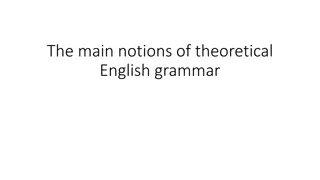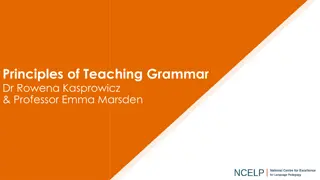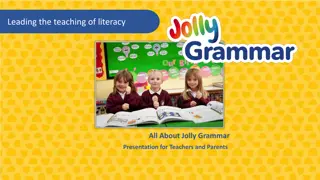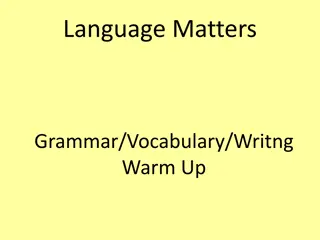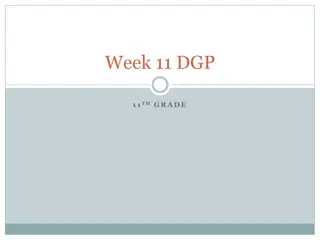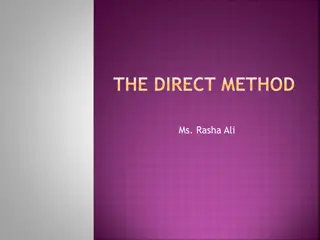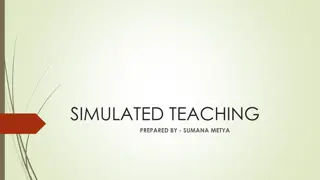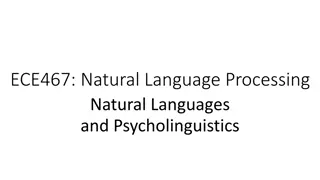
Teaching Grammar and Language Concepts in Primary Education
Explore effective teaching strategies for grammar and language concepts in primary language lessons. Learn about word classes, punctuation, vowels and consonants, gender of nouns, and engaging activities to enhance language learning in young learners.
Download Presentation

Please find below an Image/Link to download the presentation.
The content on the website is provided AS IS for your information and personal use only. It may not be sold, licensed, or shared on other websites without obtaining consent from the author. Download presentation by click this link. If you encounter any issues during the download, it is possible that the publisher has removed the file from their server.
E N D
Presentation Transcript
Teaching Grammar in Primary Language Lessons March 2015 Twilight Session DfE/University of Reading CPD in MFL sue@cavelanguages.co.uk
Objectives Consider the grammar objectives of the Programme of Study Discuss how grammatical knowledge could be taught Demonstrate activities for teaching grammar in the first two years of language learning
Word Class Actions Try allocating an action for each type of word class to aid understanding and recall of the concept. Noun Verb Adverb Conjunction Adjective Preposition Pronoun
Word Classes and Physical Punctuation Use the opportunity of teaching new vocabulary to make references to its word class. e.g. classroom actions = verbs coutez regardez Create sentences with a simple connective using physical actions for punctuation. Voici un crayon, un stylo et une r gle.
Consonants and Vowels Reinforce the meaning of vowels and consonants by describing their sequence in a familiar word. e.g. guess which colour adjective rouge bleu vert consonne, voyelle, voyelle, consonne, voyelle consonne, voyelle, consonne, consonne
Gender of Nouns masculine feminine nouns Make comparisons with other languages which also have this concept Try colour coding flashcards for each gender Teach masculine nouns together to highlight the difference before teaching feminine nouns Always teach with an article in front of the noun feminine For speakers of English, this is a difficult concept to grasp which needs much practice. Always use the terminology masculine and
Gender of Nouns Activities Give out cards with words masculine and feminine on them. Read out nouns and children lift up the correct gender card. Allocate a gender card to each group of children. Read out nouns and each group tries to beat the other one to claim the word for their group. Display nouns in the classroom grouped according to gender. Read out a story and every time the children hear and identify a masculine or feminine noun, they hold up the correct gender card. masculine feminine
Plural Nouns Discuss the meaning of the words singular and plural Ask the children stand alone if you say singular and stand with someone else if you say plural Make a comparison with English or other languages spoken by the class as how to make a French noun plural Hold flashcards of singular and plural nouns so the class cannot see them. The children take turns to guess what is on the card by naming either a singular or plural noun. Make sets of singular and plural image cards with matching word cards and the children play a memory game
Plural Nouns and a Dictionary Make sure the children are familiar with using a bi-lingual dictionary French at the front English at the end Practise looking up nouns in French in the dictionary and making them plural Using a dictionary to find words, the children create their own mini-book in the style of the Hungry Caterpillar called Le monstre a faim.. each day it eats more and more unusual things
Sentence building the position of adjectives Ask the children to recall the meanings of the word classes using the actions. Invite children to hold word cards representing the noun and adjective and stand in the correct order.
Using a language scaffold un chat un chien un cochon un lion un mouton un papillon bleu. jaune. vert. rouge. noir. violet. C est Ce + est = C est this an opportunity to explain elision C est un this is an opportunity to explain liaison
Sentence building activities using the language scaffold Children hold cards facing towards them with images to represent elements of a sentence using a noun and adjective and the class takes turns to guess the correct words from a list. When the correct word is guessed, the image is displayed the guessing continues until the complete sentence is discovered. C est un
Sentence building activities using the language scaffold The children write a sentence on a mini white board and you do likewise. Ask the children to stand up and as you read out your sentence if theirs is not the same as yours, they sit down. Those left standing at the end win a point. Write sentences on card and cut up into individual words. Distribute the cards and the children have to find others in the room to make a sentence. C un papillon est vert.
Sentence building activities using the language scaffold Unique sentence The children write down sentences using the language scaffold, trying to make combinations which they think no-one else will use. In groups, each child reads out one of their sentences, if no- one else in the room has the same one, they win a point for their team. This is a great activity to practise listening, speaking, reading and writing skills as well as demonstrate grammatical understanding.
More activity ideas All these activities are from the resource book More Fun Ideas for Advancing Modern Foreign Languages in the Primary Classroom Brilliant Publications Which ones will you try?


